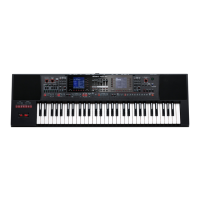13
User Program Edit Parameters
“Mono” means that you can only play one note at a time. You could
select this mode to play a trumpet or woodwind part in a more
natural way.
“Poly,” on the other hand, means that you can play chords using the
selected part.
Parameter Value
Mono/Poly Poly, Mono
NOTE
You can’t change the Mono/Poly setting of the UP3 part.
Portamento Time
“Portamento” means that the pitch doesn’t change in clearly
dened steps: it produces glides from one note to the next. Use the
this parameter to specify the speed at which those glides are carried
out. The higher the value, the slower the transitions.
Parameter Value
Portamento Time 0–127
NOTE
You can’t change the Portamento Time setting of the UP3 part.
Cut O
This lter parameter allows you to make the selected sound darker or
brighter. Positive settings mean that more overtones will be allowed
to pass, so that the sound becomes brighter. The further this value is
set in the negative direction, the fewer overtones will be allowed to
pass and the sound will become softer (darker).
Setting
Characteristics of a low-pass lter
Cuto frequency
Frequency
NOTE
For some sounds, positive (+) Cuto settings will cause no
noticeable change because the preprogrammed Cuto
parameter is already set to its maximum value.
Parameter Value
Cut O -64–+63
Resonance
When the Resonance value is increased, the overtones in the area
of the cuto frequency will be emphasized, creating a sound with a
strong character.
Parameter VALUE
Resonance -64–+63
NOTE
For some sounds, negative (–) “Resonance” settings may
produce no noticeable change because the Resonance is already
set to the minimum value.
Attack (only for Tones)
This parameter adjusts the onset of the sound. Negative values
speed up the attack, so that the sound becomes more aggressive.
Parameter Value
Attack -64–+63
Decay
This parameter adjusts the time over which the sound’s volume and
cuto frequency fall from the highest point of the attack down to the
sustain level.
Parameter Value
Decay -64–+63
NOTE
Percussive sounds usually have a sustain level of “0.” Piano and
guitar sounds are in this category. Holding the keys for a long
time will have little eect on the duration of the notes you are
playing, even if you select a high value here.
Release
This parameter adjusts the time over which the sound will decay
after the note is released until it is no longer heard. The cuto
frequency will also fall according to this setting.
Parameter Value
Release -64–+63
Vibrato Rate
This parameter adjusts the speed of the pitch modulation.
Positive (+) settings make the preset pitch modulation faster and
negative (–) settings make it slower.
Parameter Value
Vibrato Rate -64–+63
Vibrato Depth
This parameter adjusts the intensity of the pitch modulation. Positive
(+) settings mean that the “wobble” becomes more prominent,
while negative (–) settings make it shallower.
Parameter Value
Vibrato Depth -64–+63
Vibrato Delay
This parameter adjusts the time required for the vibrato eect to
begin. Positive (+) settings increase the time before vibrato will begin
and negative settings shorten the time.
Parameter Value
Vibrato Delay -64–+63
Keyboard Part MFX Parameters
This function group can be selected using [MENU]
0
“User
Program Edit”
0
“Keyboard Part MFX.” Your E-A7 contains a
multi-eects processor that can be used for processing any keyboard
part you like (There are also 2 Mfx processors for the style parts).
Type: Selects the MFX type.
Keyboard MFX Edit: Accesses a page where you can edit the
parameters of the selected MFX.
MFX Switch ([F5] button): Turns MFX on/o. Turn this o if you
don’t want to apply MFX.
Mfx Type
The E-A7 provides 84 dierent multi-eect types, some of which
are combinations of two eects for added exibility. This parameter
allows you to select the desired type. The available types are:
1. Thru
29. OD
0
Delay
57. VK Rotary
2. Stereo EQ
30. DST
0
Chorus
58. 3D Chorus
3. Overdrive
31. DST
0
Flanger
59. 3D Flanger
4. Distortion
32. DST
0
Delay
60. 3D Step Flgr
5. Phaser
33. EH
0
Chorus
61. Band Chorus
6. Spectrum
34. EH
0
Flanger
62. Band Flanger

